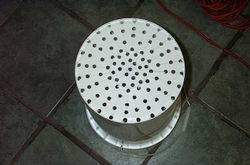hey, cactus! i was about to declare you awol! good to hear from you! i don't know if you have kept up with the thread or not, but i have harvested every one so far.
still seeing the results of various media experiments before the switch to 100% coco. love the stuff. i switched before harvesting one based on observing the plants. the coco plants are bigger, more robust plants. obvious difference. i'll harvest the first one in three weeks.
sorry about your plants. i need one transplant per week without fail so i take two first class cuttings every week. as they don't all grow out at the same rate i have multiple choices every week. i throw out a lot of large, fully rooted clones that have gotten larger than about 8".
your design looks good but i would give thought to installing an external standpipe in case of the need to overflow or change the res or to check ec or ph. in your design it should be slightly higher than the float controlled level.
i really like the split ring trick. is the screen glued on too?
there is no way to install that float valve without it being dead center. i like your solution to the problem.
the first plant with no cloth wick, last week's root ball from immediately above, yielded 9.74 oz. It was 90/10 turface/coco. It was switched to the jack's stuff three weeks before.
The jack's hydro formula is doing exactly what they said it would in ro water. They only problem i've had was my fault. The largest plant in the photos below was on my flora nova, calcium nitrate, epsom salts recipe for the first week after transplant as an 8” clone. Then an abrupt switch to jacks, which ph'd at 5.2-5.4 in my ro water. I figured that might be ok so I did not adjust it at all. About a week later I noticed a couple of leaves with slight inter-veinal chlorosis. Looked like a magnesium deficiency. Which is highly unlikely since they put a whopping 6.36% mag in their formula. Which left ph as the culprit. I re-read their instructions and they recommend keeping ph at 6-6.5 with their product. So I added gh's dry ph up, which is potassium chloride and potassium citrate, and brought the ph up to 6. end of problem. Btw, it was the only plant that showed this.
Again, good to hear from you, cactus!
The first plant is the plant discussed above at the end of four weeks, one week fnb and three weeks jack's. Same as large plant from 3-25 and 3-30.
The second is the same as small plant from same dates at end of week three. Jack's only.
The last two are end of weeks two and one, respectively. All jack's.
Hey, turbohead!
still seeing the results of various media experiments before the switch to 100% coco. love the stuff. i switched before harvesting one based on observing the plants. the coco plants are bigger, more robust plants. obvious difference. i'll harvest the first one in three weeks.
sorry about your plants. i need one transplant per week without fail so i take two first class cuttings every week. as they don't all grow out at the same rate i have multiple choices every week. i throw out a lot of large, fully rooted clones that have gotten larger than about 8".
your design looks good but i would give thought to installing an external standpipe in case of the need to overflow or change the res or to check ec or ph. in your design it should be slightly higher than the float controlled level.
i really like the split ring trick. is the screen glued on too?
there is no way to install that float valve without it being dead center. i like your solution to the problem.
the first plant with no cloth wick, last week's root ball from immediately above, yielded 9.74 oz. It was 90/10 turface/coco. It was switched to the jack's stuff three weeks before.
The jack's hydro formula is doing exactly what they said it would in ro water. They only problem i've had was my fault. The largest plant in the photos below was on my flora nova, calcium nitrate, epsom salts recipe for the first week after transplant as an 8” clone. Then an abrupt switch to jacks, which ph'd at 5.2-5.4 in my ro water. I figured that might be ok so I did not adjust it at all. About a week later I noticed a couple of leaves with slight inter-veinal chlorosis. Looked like a magnesium deficiency. Which is highly unlikely since they put a whopping 6.36% mag in their formula. Which left ph as the culprit. I re-read their instructions and they recommend keeping ph at 6-6.5 with their product. So I added gh's dry ph up, which is potassium chloride and potassium citrate, and brought the ph up to 6. end of problem. Btw, it was the only plant that showed this.
Again, good to hear from you, cactus!
The first plant is the plant discussed above at the end of four weeks, one week fnb and three weeks jack's. Same as large plant from 3-25 and 3-30.
The second is the same as small plant from same dates at end of week three. Jack's only.
The last two are end of weeks two and one, respectively. All jack's.
Hey, turbohead!
Last edited:

 ...
...
 ...
...





